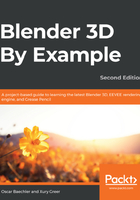
A brief history of Blender's user interface
Blender's user interface (UI) was very polarizing in the past. Older versions of Blender required the user to memorize dozens of hotkeys before it was possible to accomplish even basic tasks, which meant that many users found this hard to use. However, those were the days of Blender 2.49, and when Blender was updated to version 2.50, the UI got its first major facelift, which added many new features, more buttons, and a cleaner user experience.
Each release of Blender increments the version number by +0.01, which means 2.80 is 30 versions newer than 2.50 – that's a lot of versions! Many of these versions simply added small new features and bug fixes, but version 2.80 is just as big of an overhaul from version 2.79 as 2.50 was from version 2.49.
The original Blender included most of the basic requirements for a 3D modeling suite: 3D modeling, rigging, animating, and its internal "Blender Render" rendering engine. The earliest versions of the software were infamous for missing features such as undo and warning the user that data might be lost if they exited the program without saving first.
Its bright white UI with horizontal buttons, excessive use of tabs, and odd coloration was criticized by many users, but nevertheless, it was responsible for some amazing Open Movie projects such as "Elephant's Dream" and "Big Buck Bunny":

When Blender 2.50 rolled around, the UI was changed radically in response to user feedback. The Open Movie "Sintel" was created alongside the development of this new version to make sure that it included all of the features required for animation production. The 2.5 series of releases continued to introduce amazing features such as Cycles, the ray tracing rendering engine; the bMesh modeling system, which overhauled all of the modeling tools and allowed users to use n-gons; the new dynamic topology sculpting tools; and much more.
It quickly became a formidable modeling suite and gained popularity as the software grew all the way through to version 2.79:

Finally, the 2.8 series came around. This highly anticipated release was in development for over 3 years and overhauled many of the underlying systems that were starting to show their age. The result was a stable, fast, customizable, and user-friendly experience that provided all the modern features you would expect in a modeling suite:

This is an excellent time to learn Blender! The Blender 2.8 series of releases comes with massive improvements to the software, among other things. The user interface has received several updates that will make it more user-friendly than ever before! There has especially been a focus on making it more accessible to new users (that's you!).
So, there's your brief history lesson on Blender's UI. Now, let's break the UI down into its different sections and learn how to use it!